Water Erosion and Extension of Ground Fissures in Weihe Basin Based on DEM-CFD Coupled Modeling
Abstract
1. Introduction
2. Geological Background
3. DEM-CFD Coupled Numerical Modeling Method
3.1. Background: The Coupling of DEM and CFD
3.2. Details of the DEM-CFD Coupled Modeling Method
3.2.1. Governing Equations of the Particle Phase
3.2.2. Darcy’s Law
3.2.3. Coupling Process
3.3. Building of the Computational Model
3.4. Determination of Computational Parameters
4. Results and Analysis
4.1. Subsurface Erosion into Hidden Holes
4.2. Traction into Arches
4.3. Collapse into Sinkholes
4.4. Horizontal Extensions
5. Discussion
6. Conclusions
Author Contributions
Funding
Data Availability Statement
Conflicts of Interest
References
- Zheng, X.; Xu, J.; Wang, H.; Liu, X.; Yao, D.; Lv, J. Health risk assessment of a reservoir-type water source in the northeastern region of China. Hum. Ecol. Risk Assess. Int. J. 2017, 23, 751–766. [Google Scholar] [CrossRef]
- Lu, Y.; Xu, J.; Wang, H.; Liu, X.; Li, W. Distribution, sources and health risk assessment of contaminations in water of urban park: A case study in Northeast China. Environ. Geochem. Health 2019, 41, 2473–2489. [Google Scholar] [CrossRef]
- Burbey, T.J. The influence of faults in basin-fill deposits on land subsidence, Las Vegas Valley, Nevada, USA. Hydrogeol. J. 2002, 10, 525–538. [Google Scholar] [CrossRef]
- Peng, J.B.; Wang, F.Y.; Cheng, Y.X.; Lu, Q.Z. Characteristics and mechanism of Sanyuan ground fissures in the Weihe Basin, China. Eng. Geol. 2018, 247, 48–57. [Google Scholar] [CrossRef]
- Wang, F.Y.; Peng, J.B.; Lu, Q.Z.; Cheng, Y.X.; Meng, Z.J.; Qiao, J.W. Mechanism of Fuping ground fissure in the Weihe Basin of northwest China: Fault and rainfall. Environ. Earth Sci. 2019, 78, 10. [Google Scholar] [CrossRef]
- Zang, M.D.; Peng, J.B.; Qi, S.W. Earth fissures developed within collapsible loess area caused by groundwater uplift in Weihe watershed, northwestern China. J. Asian Earth Sci. 2019, 173, 364–373. [Google Scholar] [CrossRef]
- Li, Y.L.; Yang, J.C.; Hu, X.M. Origin of ground fissures in the Shanxi Graben system, Northern China. Eng. Geol. 2000, 55, 267–275. [Google Scholar] [CrossRef]
- Ayalew, L.; Yamagishi, H.; Reik, G. Ground cracks in Ethiopian rift valley: Facts and uncertainties. Eng. Geol. 2004, 75, 309–324. [Google Scholar] [CrossRef]
- Liu, Y.; Peng, J.B.; Jiang, F.Q.; Lu, Q.Z.; Zhu, F.J.; Qiang, X. Model test study on the formation and development of underground erosion ground fissures in the Kenya Rift Valley. J. Mt. Sci. 2022, 19, 1037–1050. [Google Scholar] [CrossRef]
- Zhao, J.D.; Shan, T. Coupled CFD-DEM simulation of fluid-particle interaction in geomechanics. Powder Technol. 2013, 239, 248–258. [Google Scholar] [CrossRef]
- Wang, Y.; Xia, A.; Qin, G. Probabilistic modeling for reliability analysis of buried pipelines subjected to spatiotemporal earthquakes. Probabilistic Eng. Mech. 2022, 69, 103315. [Google Scholar] [CrossRef]
- Kriebitzsch, S.H.L.; van der Hoef, M.A.; Kuipers, J.A.M. Fully resolved simulation of a gas-fluidized bed: A critical test of DEM models. Chem. Eng. Sci. 2013, 91, 1–4. [Google Scholar] [CrossRef]
- Yang, G.C.; Jing, L.; Kwok, C.Y.; Sobral, Y.D. A comprehensive parametric study of LBM-DEM for immersed granular flows. Comput. Geotech. 2019, 114, 15. [Google Scholar] [CrossRef]
- Ferziger, J.H.; Peric, M. Computational Methods for Fluid Dynamics; Springer: Berlin, Germany, 1999. [Google Scholar]
- Meng, Z.J.; Wang, F.Y.; Peng, J.B.; Qiao, J.W.; Wen, H.G. Characteristics and mechanism of Jiaocheng ground fissure in Taiyuan Basin, China. Environ. Earth Sci. 2023, 82, 10. [Google Scholar] [CrossRef]
- Sun, P.; Peng, J.B.; Chen, L.W.; Yin, Y.P.; Wu, S.R. Weak tensile characteristics of loess in China—An important reason for ground fissures. Eng. Geol. 2009, 108, 153–159. [Google Scholar] [CrossRef]
- Guyer, J.E.; Wheeler, D.; Warren, J.A. FiPy: Partial Differential Equations with Python. Comput. Sci. Eng. 2009, 11, 6–15. [Google Scholar] [CrossRef]
- Tsuji, Y.; Kawaguchi, T.; Tanaka, T. Discrete particle simulation of two-dimensional fluidized bed. Powder Technol. 1993, 77, 79–87. [Google Scholar] [CrossRef]
- Guo, Y.; Yang, Y.; Yu, X. Influence of particle shape on the erodibility of non-cohesive soil: Insights from coupled CFD-DEM simulations. Particuology 2018, 39, 12–24. [Google Scholar] [CrossRef]
- Wang, X.K.; Huang, B.; Tang, Y.; Hu, T.T.; Ling, D.S. Microscopic mechanism and analytical modeling of seepage-induced erosion in bimodal soils. Comput. Geotech. 2022, 141, 15. [Google Scholar] [CrossRef]
- Itasca Consulting Group, Inc. PFC 5.0 Documentation, User’s Guide; 2018. Available online: https://www.itascacg.com/software/pfc (accessed on 14 June 2023).
- Itasca Consulting Group, Inc. PFC—Particle Flow Code, Ver. 5.0; 2014. Available online: https://www.itascacg.com/software/pfc (accessed on 14 June 2023).
- Difelice, R. The Voidage Function for Fluid Particle Interaction Systems. Int. J. Multiph. Flow 1994, 20, 153–159. [Google Scholar] [CrossRef]
- Shire, T.; O’Sullivan, C.; Hanley, K.J.; Fannin, R.J. Fabric and effective stress distribution in internally unstable soils. J. Geotech. Geoenvironmental Eng. 2014, 140, 04014072. [Google Scholar] [CrossRef]
- Indraratna, B.; Haq, S.; Rujikiatkamjorn, C.; Israr, J. Microscale boundaries of internally stable and unstable soils. Acta Geotech. 2022, 17, 2037–2046. [Google Scholar] [CrossRef]
- Shafipour, R.; Soroush, A. Fluid coupled-DEM modelling of undrained behavior of granular media. Comput. Geotech. 2008, 35, 673–685. [Google Scholar] [CrossRef]
- Tao, H.; Tao, J.L. Quantitative analysis of piping erosion micro-mechanisms with coupled CFD and DEM method. Acta Geotech. 2017, 12, 573–592. [Google Scholar] [CrossRef]
- Hu, Z.; Zhang, Y.D.; Yang, Z.X. Suffusion-induced deformation and microstructural change of granular soils: A coupled CFD-DEM study. Acta Geotech. 2019, 14, 795–814. [Google Scholar] [CrossRef]
- Cleary, P.W. DEM simulation of industrial particle flows: Case studies of dragline excavators, mixing in tumblers and centrifugal mills. Powder Technol. 2000, 109, 83–104. [Google Scholar] [CrossRef]
- Zhang, D.M.; Gao, C.P.; Yin, Z.Y. CFD-DEM modeling of seepage erosion around shield tunnels. Tunn. Undergr. Space Technol. 2019, 83, 60–72. [Google Scholar] [CrossRef]
- Tran, K.M.; Bui, H.; Sanchez, M.; Kodikara, J. A DEM approach to study desiccation processes in slurry soils. Comput. Geotech. 2020, 120, 13. [Google Scholar] [CrossRef]
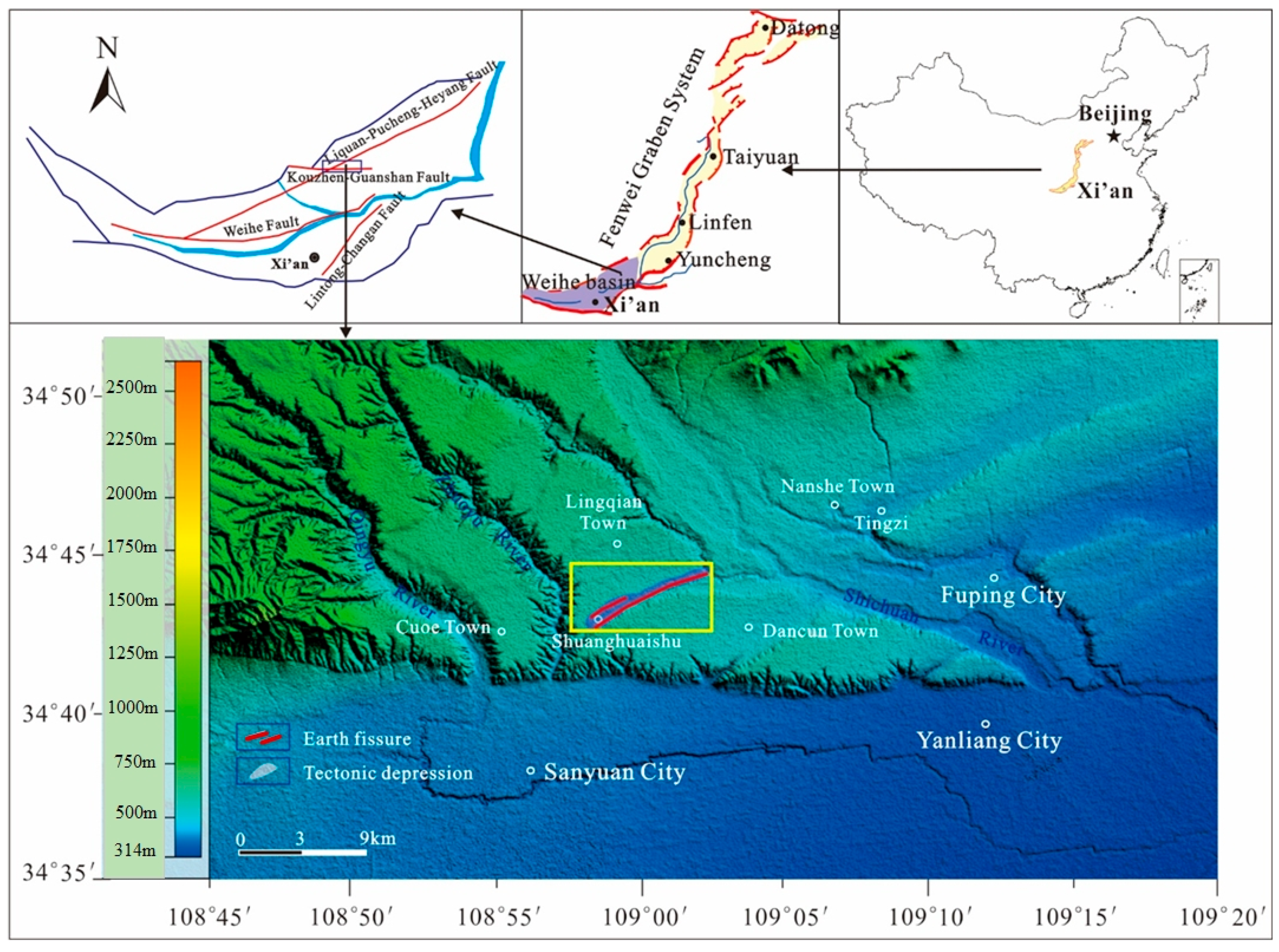
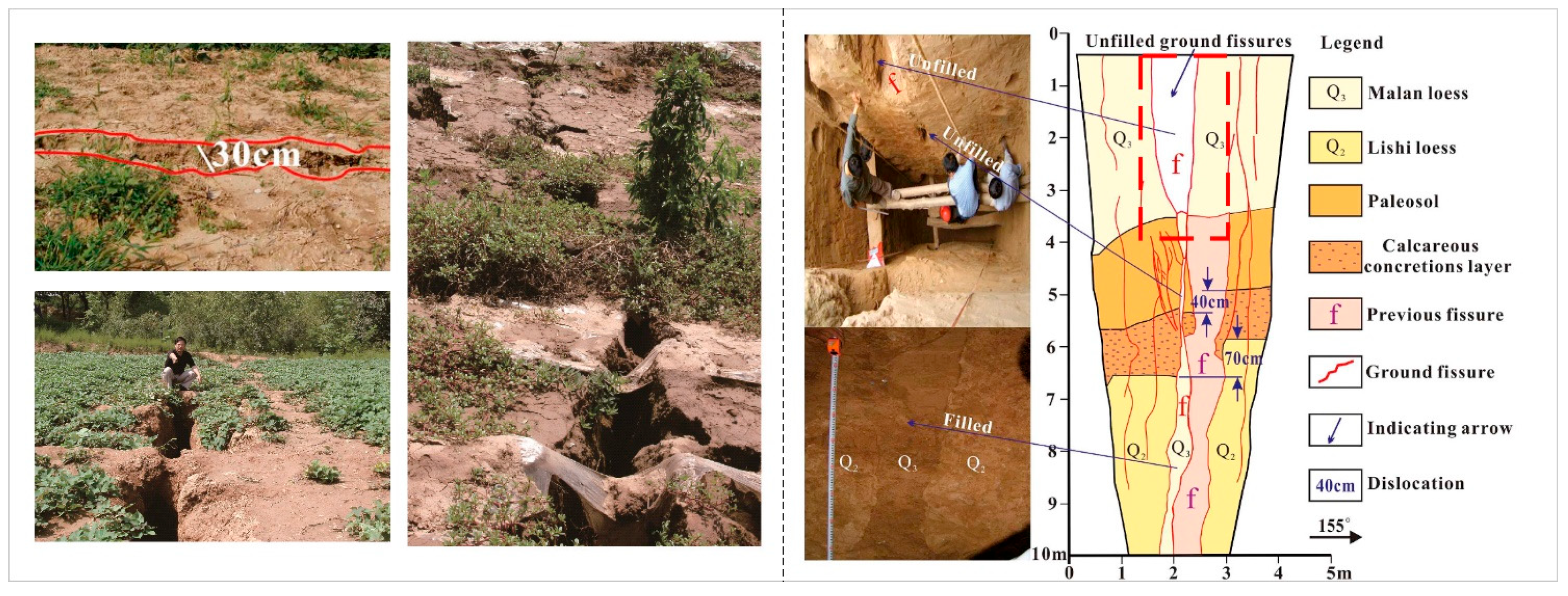

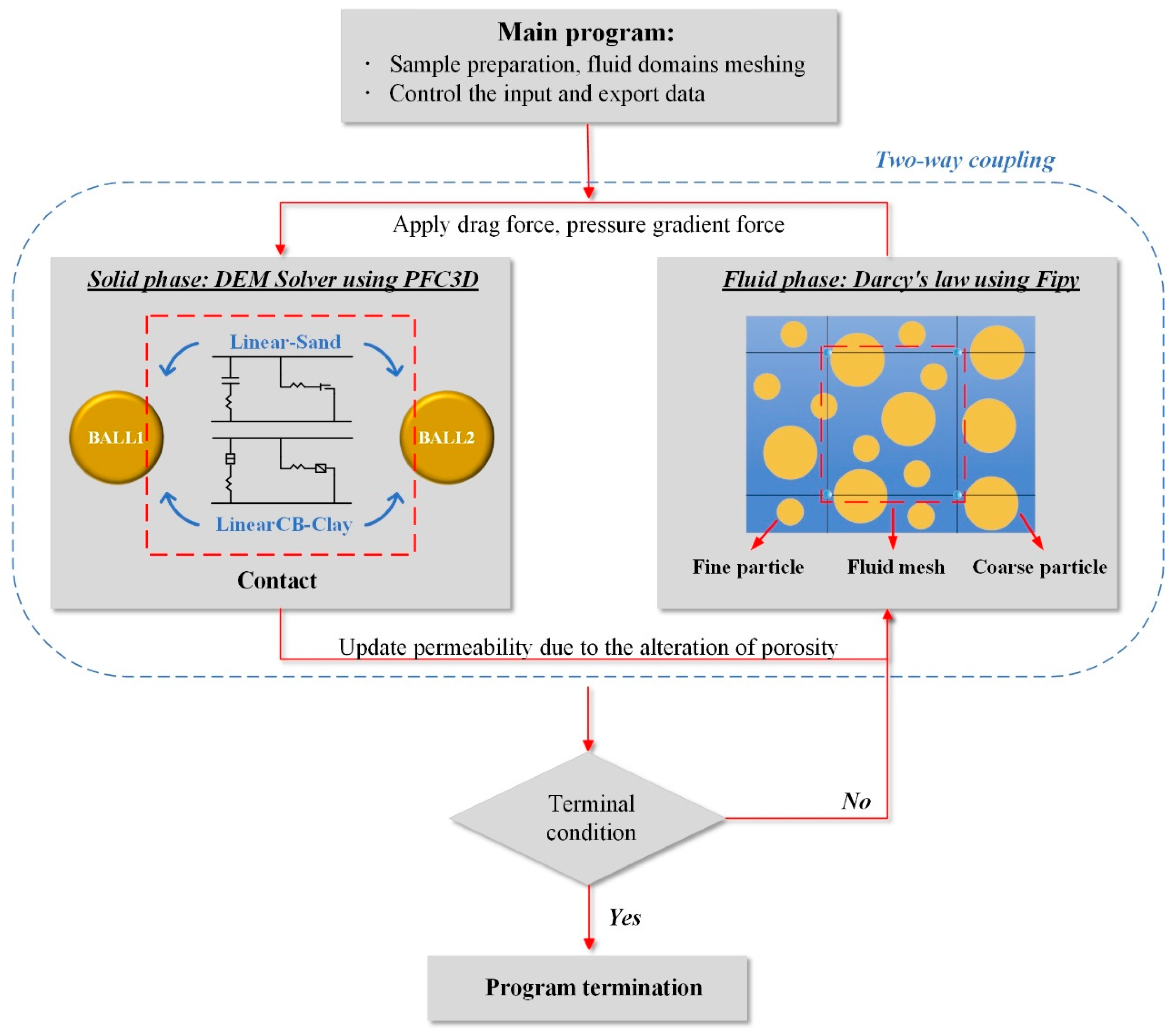

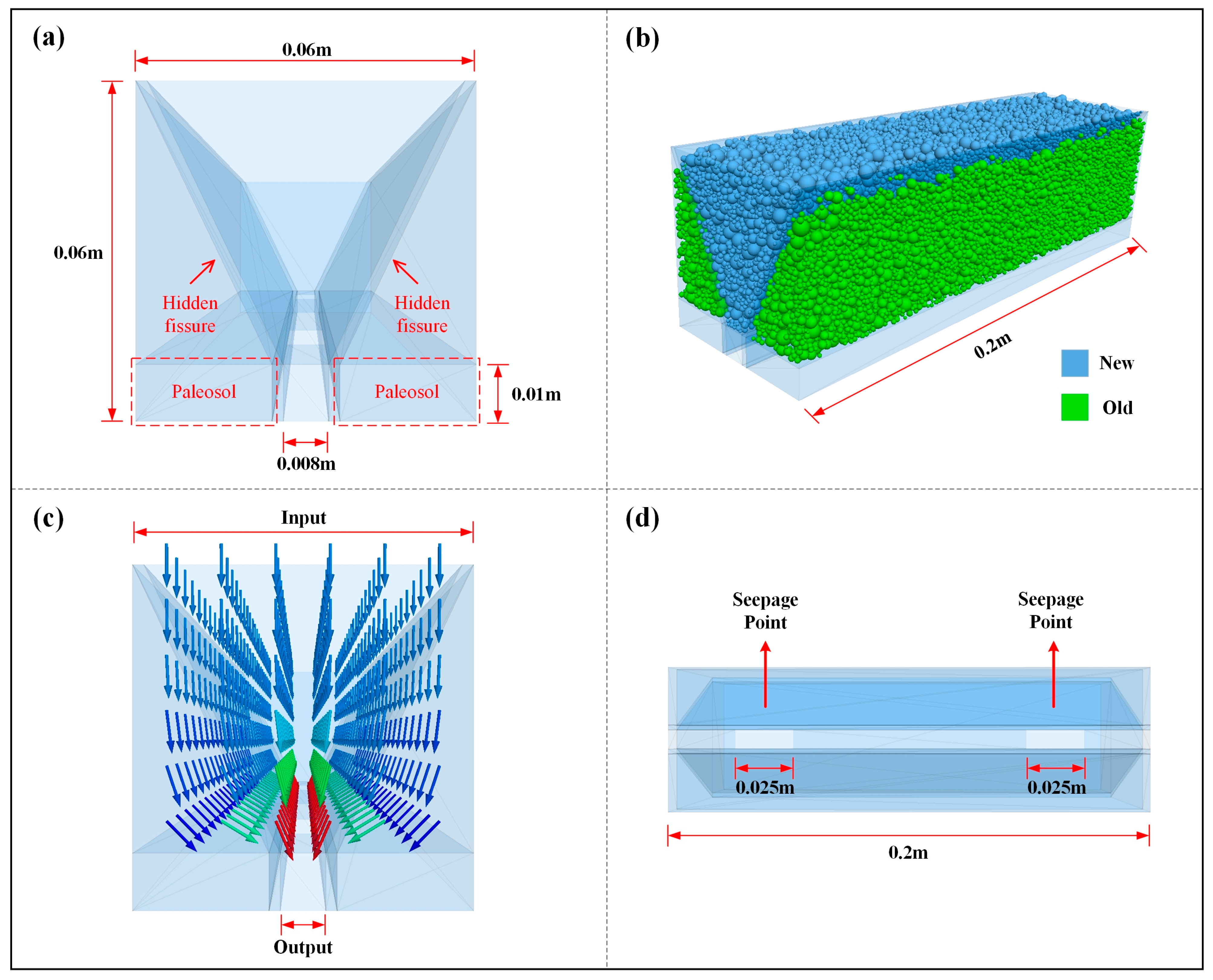
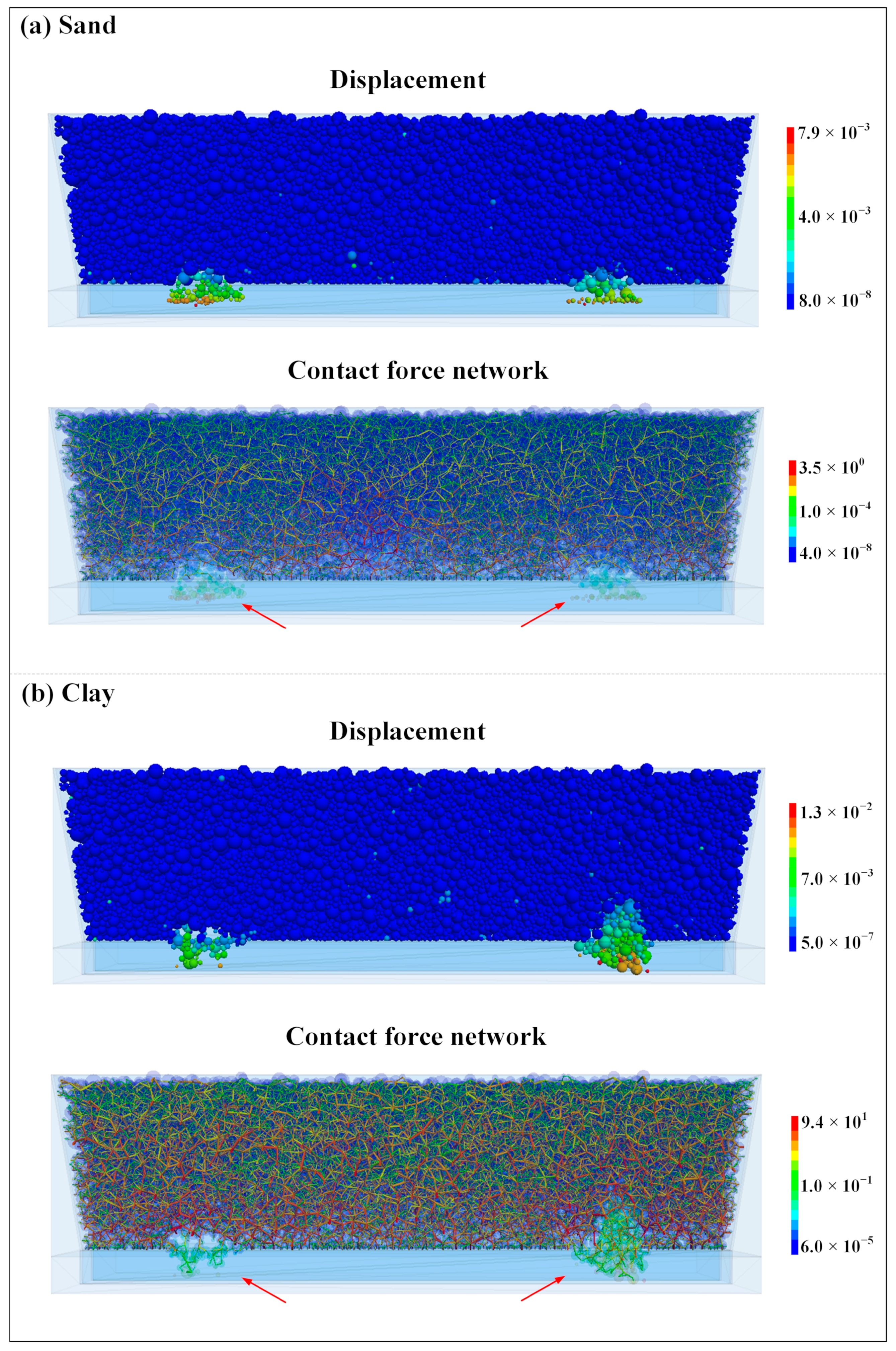
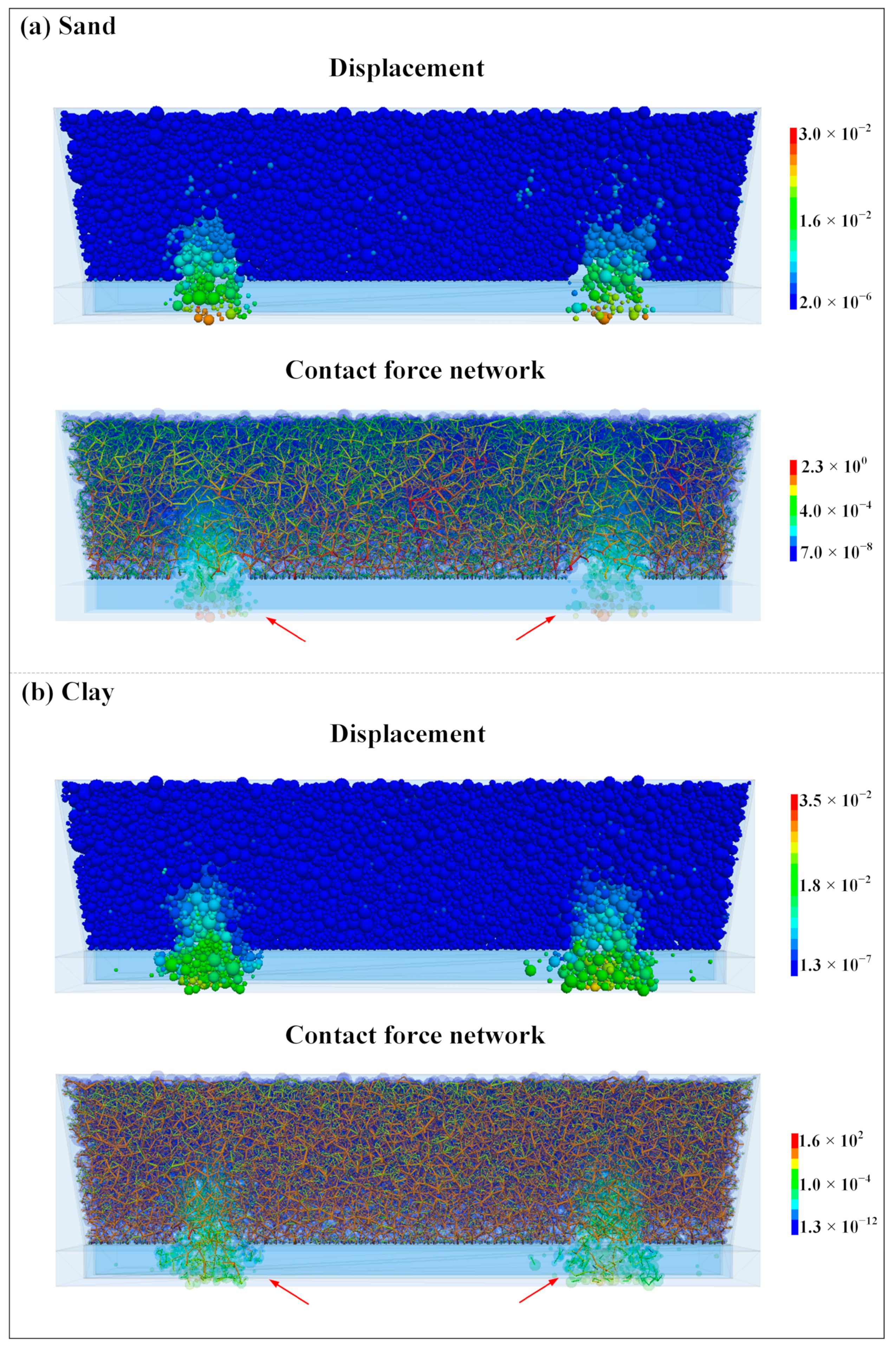
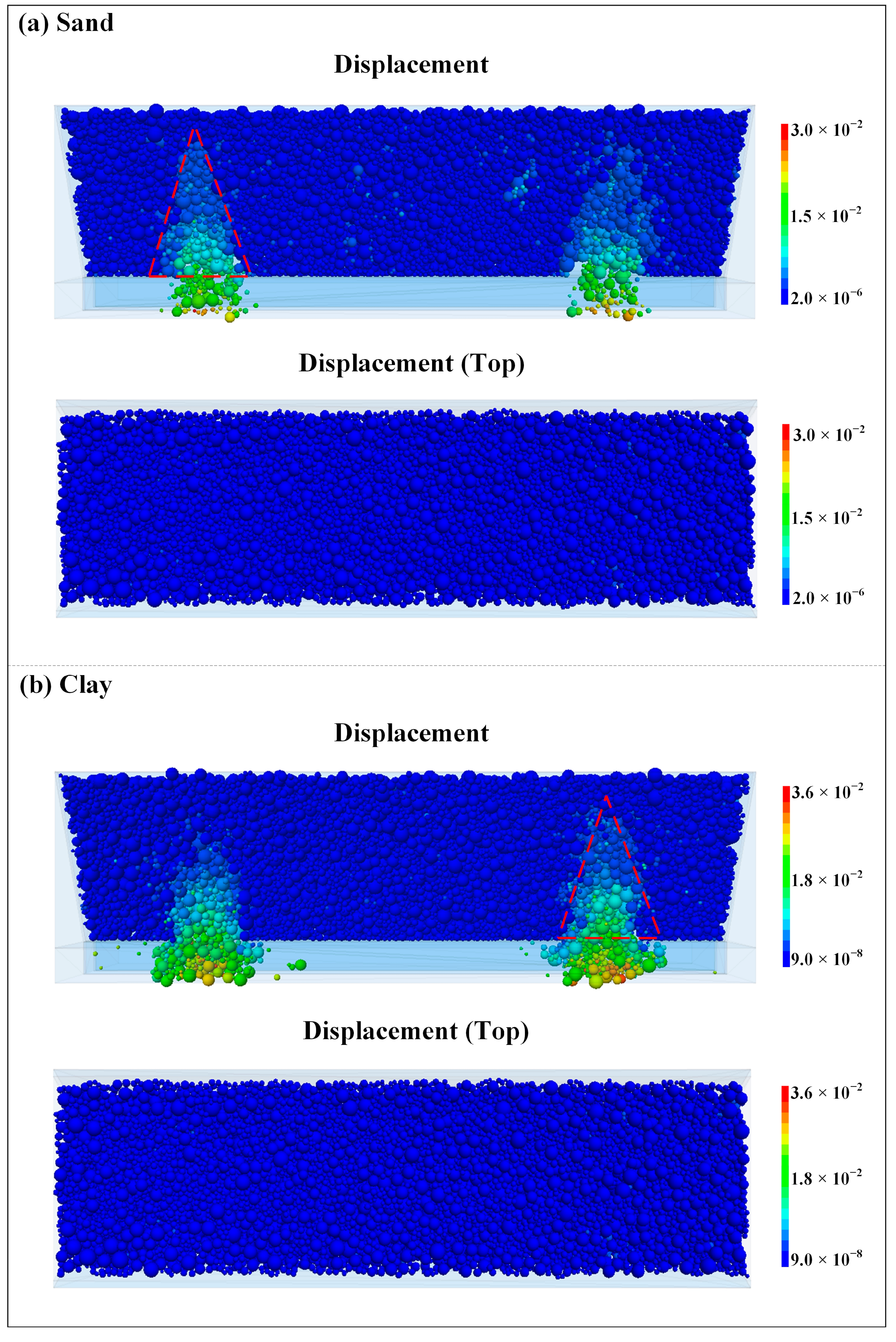
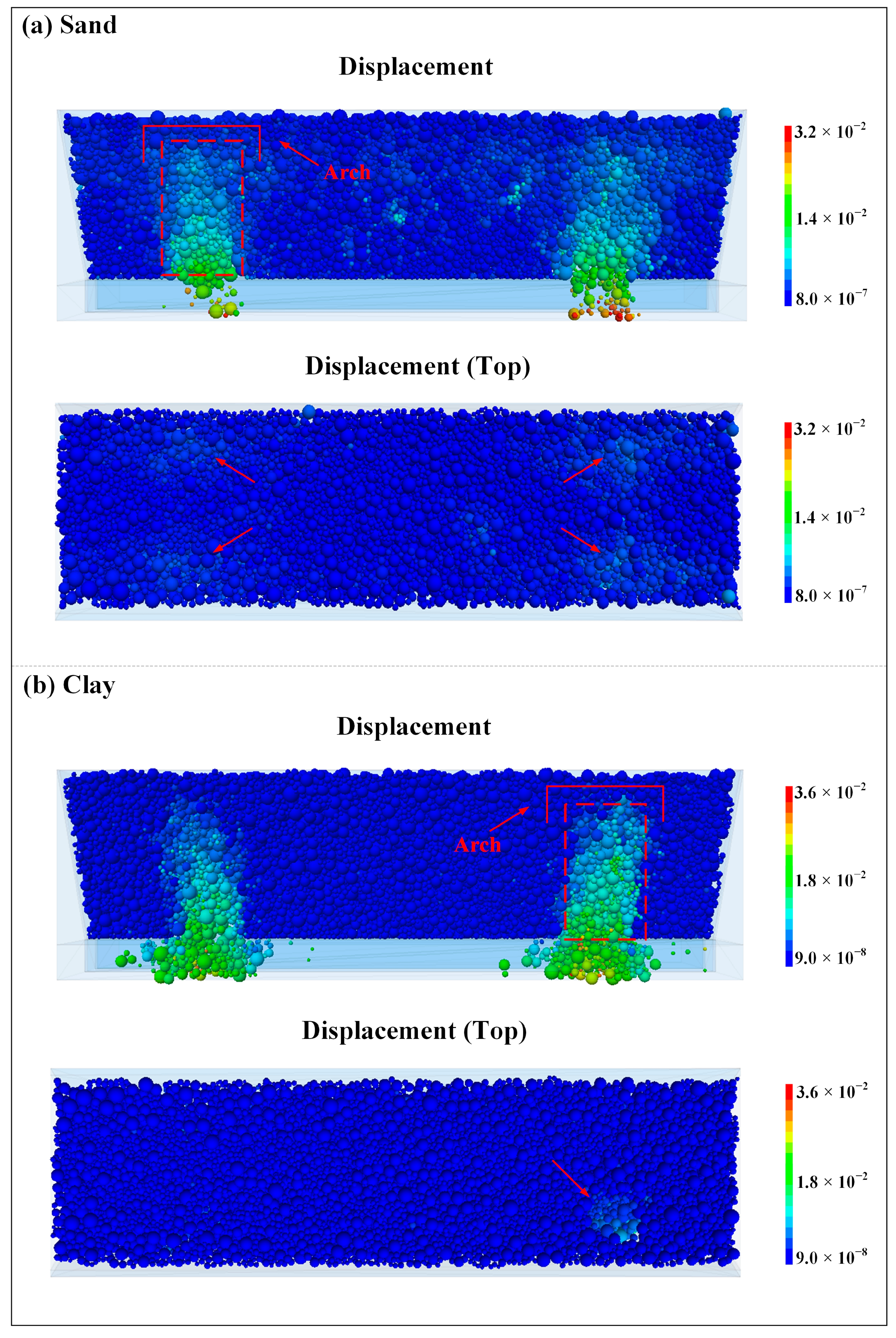
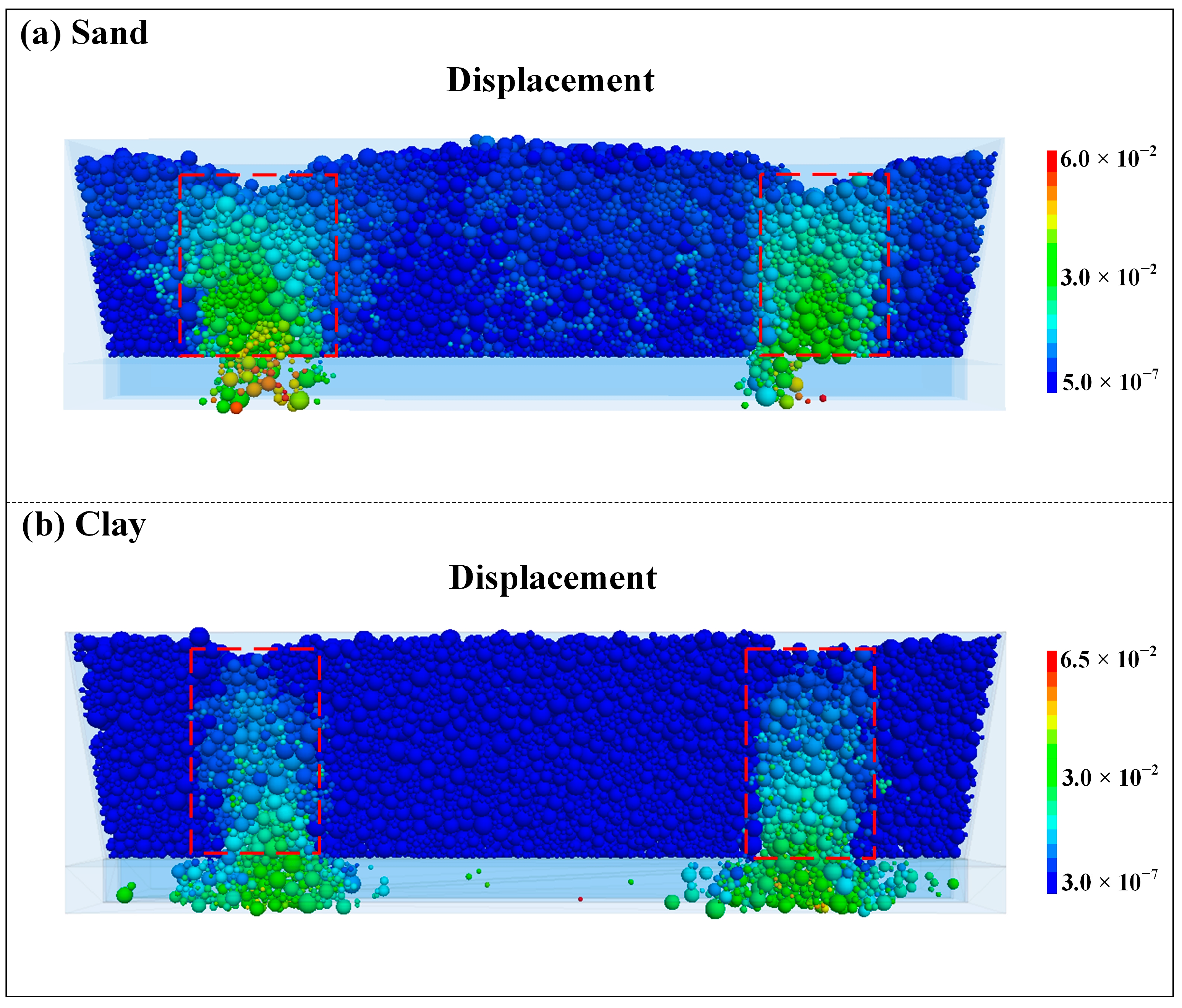
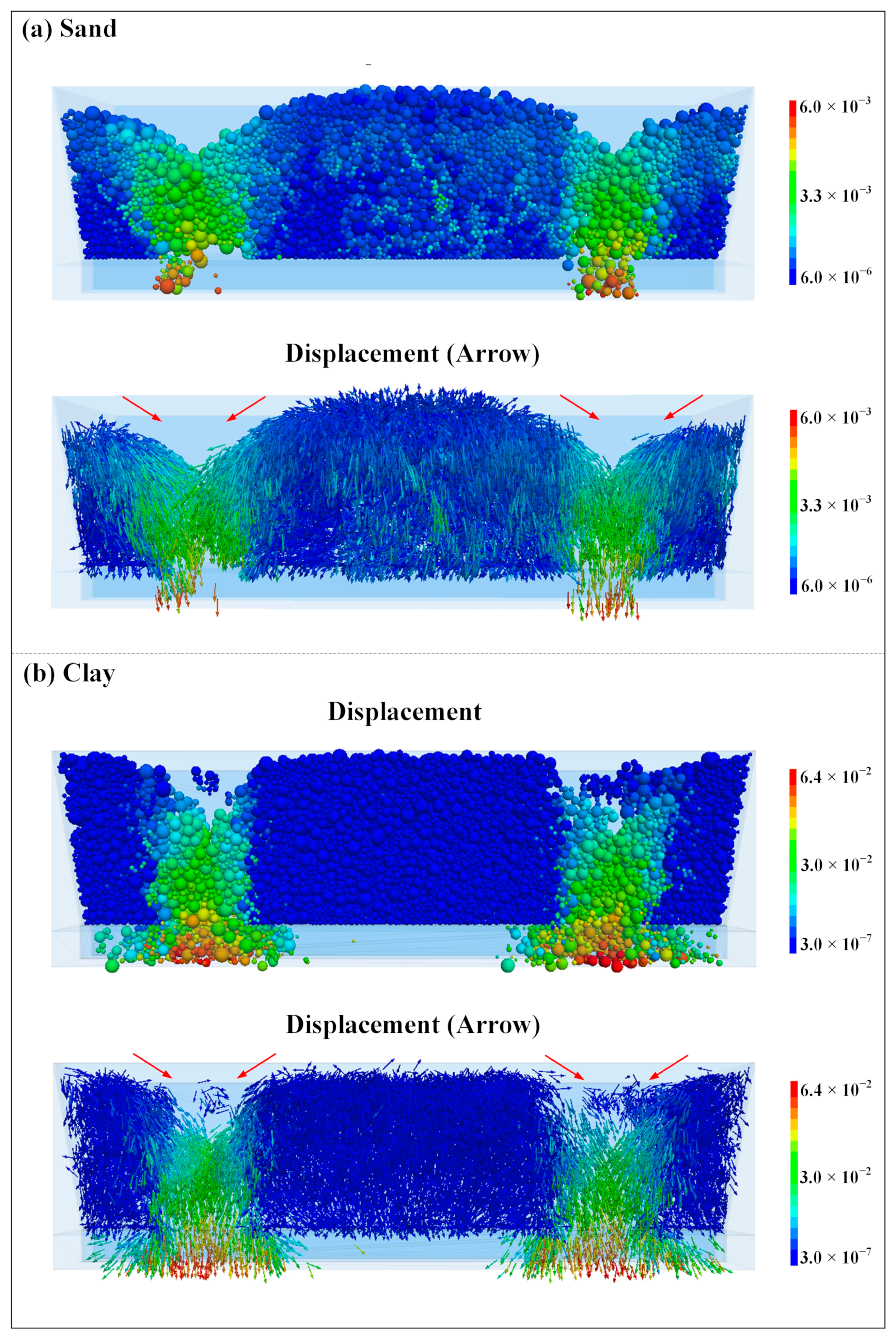
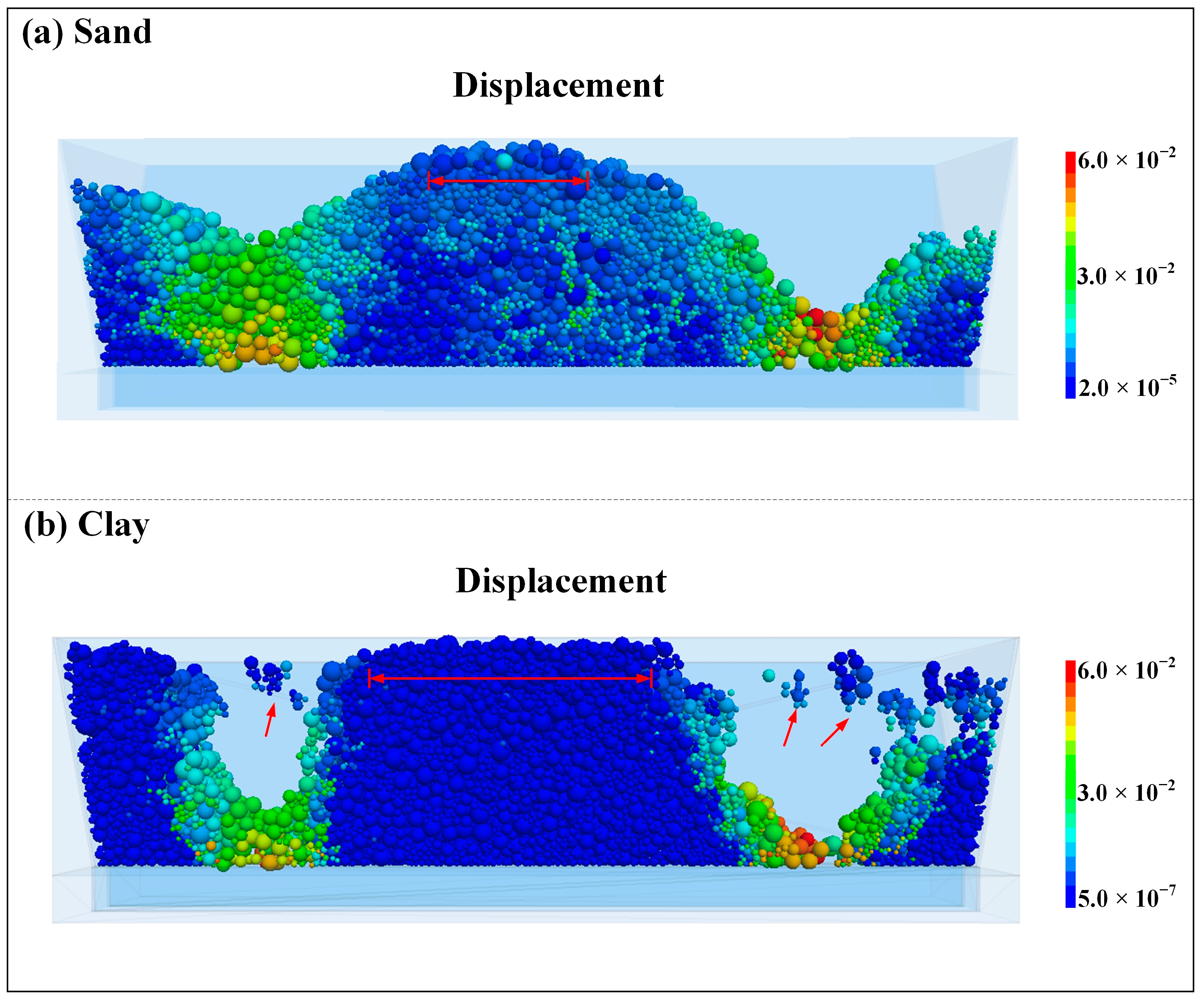
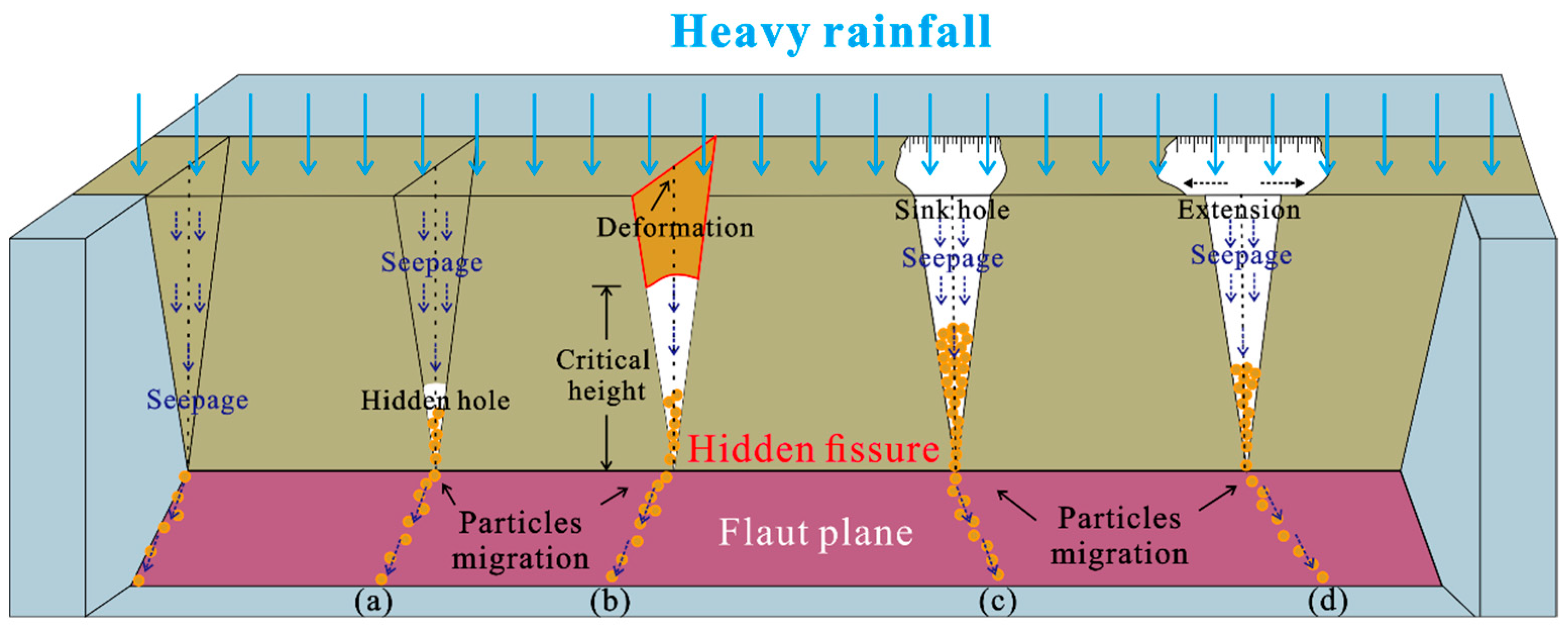
| Type | Parameters | Value |
| Solid | Maximum particle diameter (m) | 0.005 |
| Minimum particle diameter (m) | 0.001 | |
| Particle density (g/cm3) | 2600 | |
| Normal stiffness (N/m) | 1.0 × 106 | |
| Shear stiffness (N/m) | 1.0 × 106 | |
| (CB) Tensile strength (N) | 1.0 × 101 | |
| (CB) Shear strength (N) | 5.0 × 101 | |
| Friction coefficient | 0.5 | |
| Fluid | Fluid density (kg/m3) | 1000 |
| Fluid viscosity (Pa·s) | 0.1 |
Disclaimer/Publisher’s Note: The statements, opinions and data contained in all publications are solely those of the individual author(s) and contributor(s) and not of MDPI and/or the editor(s). MDPI and/or the editor(s) disclaim responsibility for any injury to people or property resulting from any ideas, methods, instructions or products referred to in the content. |
© 2023 by the authors. Licensee MDPI, Basel, Switzerland. This article is an open access article distributed under the terms and conditions of the Creative Commons Attribution (CC BY) license (https://creativecommons.org/licenses/by/4.0/).
Share and Cite
Wang, F.; Wang, F.; Gong, X.; Zhang, Y.; Li, G. Water Erosion and Extension of Ground Fissures in Weihe Basin Based on DEM-CFD Coupled Modeling. Water 2023, 15, 2321. https://doi.org/10.3390/w15132321
Wang F, Wang F, Gong X, Zhang Y, Li G. Water Erosion and Extension of Ground Fissures in Weihe Basin Based on DEM-CFD Coupled Modeling. Water. 2023; 15(13):2321. https://doi.org/10.3390/w15132321
Chicago/Turabian StyleWang, Fujiang, Feiyong Wang, Xulong Gong, Yan Zhang, and Guoqing Li. 2023. "Water Erosion and Extension of Ground Fissures in Weihe Basin Based on DEM-CFD Coupled Modeling" Water 15, no. 13: 2321. https://doi.org/10.3390/w15132321
APA StyleWang, F., Wang, F., Gong, X., Zhang, Y., & Li, G. (2023). Water Erosion and Extension of Ground Fissures in Weihe Basin Based on DEM-CFD Coupled Modeling. Water, 15(13), 2321. https://doi.org/10.3390/w15132321







